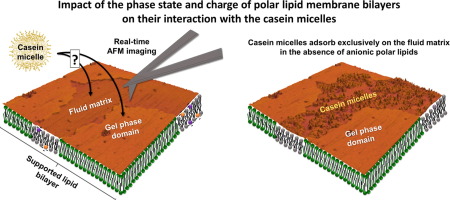Journal of Colloid and Interface Science ( IF 9.9 ) Pub Date : 2018-09-11 , DOI: 10.1016/j.jcis.2018.09.033 Sameh Obeid , Fanny Guyomarc'h , Elisabeth David-Briand , Frédéric Gaucheron , Alain Riaublanc , Christelle Lopez

|
The biological membrane surrounding fat globules in milk (milk fat globule membrane; MFGM) is an interface involved in many biological functions and interactions with the surrounding proteins or lipolytic enzymes in the gastro-intestinal tract during digestion. The MFGM exhibits lateral heterogeneities resulting from the different phase states and/or head-group charge of the polar lipids, which were both hypothesized to drive interaction with the casein micelles that is the major milk protein assembly. Atomic force microscopy (AFM) imaging was used to track the interactions of casein micelles with hydrated supported lipid bilayers of different composition, phase state and charge. Zeta-potential and Langmuir isotherms of the different polar lipids offered additional information necessary to interpret AFM observations. We showed that the negatively-charged casein micelles did not interact with milk sphingomyelin in the gel or liquid-ordered phases but did interact with polar lipids in the liquid-disordered phase (unsaturated polar lipids and milk sphingomyelin above its melting point). A wide intermolecular distance between polar lipids allowed protein adsorption on the membranes. However, the presence of the anionic polar lipids phosphatidylserine and phosphatidylinositol prevented any interaction with the casein micelles, probably due to electrostatic repulsion. These results open perspectives for the preparation of tailored emulsions covered by polar lipids able to modulate the interfacial interactions with proteins.
中文翻译:

酪蛋白微团证明,乳极性脂质膜双层的相和电荷决定了它们与蛋白质的选择性相互作用。
牛奶中的脂肪小球周围的生物膜(牛奶脂肪小球膜; MFGM)是一种界面,参与消化过程中许多生物学功能以及与胃肠道中周围蛋白质或脂解酶的相互作用。MFGM表现出由于极性脂质的不同相态和/或头基电荷而产生的横向异质性,均被假设为驱动与酪蛋白微团相互作用的酪蛋白微团,而酪蛋白微团是主要的乳蛋白组装体。原子力显微镜(AFM)成像用于跟踪酪蛋白胶束与不同组成,相态和电荷的水合支持的脂质双层的相互作用。不同极性脂质的Zeta电位和Langmuir等温线提供了解释AFM观测所必需的其他信息。我们显示带负电荷的酪蛋白胶束在凝胶或液体有序相中不与牛奶鞘磷脂相互作用,但在液体无序相中与极性脂质相互作用(不饱和极性脂质和牛奶鞘磷脂在其熔点以上)。极性脂质之间的大分子间距离允许蛋白质吸附在膜上。然而,阴离子极性脂质磷脂酰丝氨酸和磷脂酰肌醇的存在阻止了与酪蛋白胶束的任何相互作用,这可能是由于静电排斥。这些结果为制备能够调节与蛋白质的界面相互作用的极性脂质覆盖的量身定制的乳液开辟了前景。


























 京公网安备 11010802027423号
京公网安备 11010802027423号